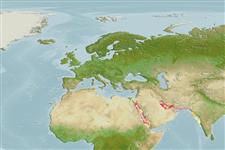>
Eupercaria/misc (Various families in series Eupercaria) >
Labridae (Wrasses) > Corinae
Etymology: Macropharyngodon: Greek, makros = great + Greek, pharyngx = pharynx + Greek,odous = teeth (Ref. 45335).
More on author: Randall.
Environment: milieu / climate zone / depth range / distribution range
البيئة
بحري مرتبطة بالشعاب; غير مهاجرة; نطاق العمق 4 - 16 m. Tropical
Western Indian Ocean: Red Sea.
الحجم / وزن / العمر
Maturity: Lm ? range ? - ? cm
Max length : 9.5 cm SL ذكر/ مختلط الجنس; (Ref. 2694)
وصف مختصر
مفاتيح التعريف | الوصف الخارجي | قياسات المظهر الخارجي
الأشواك الظهرية (المجموع) : 9; الأشعة الظهرية الناعمة (المجموع) : 11; شوكة شرجية: 3; أشعه شرجية لينه: 11. This species is distinguished by the following characters: D IX,11; A III,11; pectoral rays 12 (including upper rudimentary ray); complete lateral line, angling downward below last 3 or 4 dorsal rays to straight peduncular portion, 27 pored scales (plus 1 on base of caudal fin); anterior lateral-line scales with 2 or 3 (rarely 4) pores; gill rakers 14-17; body depth 2.6-2.9 in SL; head length (HL) 2.95-3.05 in SL; snout short, 3.3-3.7 in HL; upper jaw with 2 pairs of canine teeth, 1st pair straight and strongly projecting anteriorly, 2nd pair about two-thirds as long, with tips recurved and outflaring; lower jaw with a medial pair of long, straight, forward-jutting, canine teeth, each with an adjacent more slender canine about two-thirds as long, with recurved tip; side of jaws with single row of close-set conical teeth, progressively shorter posteriorly; a very large, slender, forward-projecting, canine tooth posteriorly on upper jaw; lower pharyngeal plate with an enormous central molariform tooth, on each side anteriorly with a row of small conical teeth, continuing as a single row on the long anterior process; each of the pair of upper pharyngeal plates with 2 large, nearly square molars, preceded by a patch of small stout conical teeth; orbit diameter 4.25-4.95 in HL; origin of dorsal fin slightly anterior to a vertical at upper end of gill opening; first dorsal spine 4.25-5.25 in HL; remaining spines progressively longer, 9th 3.1-3.25 in HL; 5th or 6th dorsal soft ray longest, 1.9-2.2 in HL; 3rd anal spine longest, 2.45-3.55 in HL; 5th or 6th anal soft ray longest, 1.95-2.2 in HL; caudal fin slightly rounded, 1.2-1.3 in HL; pectoral fins 1.4-1.5 in HL; pelvic fins 1.35-1.8 in HL, usually reaching to or slightly posterior to origin of anal fin in mature males, usually not reaching anus in females (Ref. 93522).
Life cycle and mating behavior
النضج | التكاثر | وضع البيض | بيض | الخصوبة | Larvae
Oviparous, distinct pairing during breeding (Ref. 205).
Randall, J.E., 2013. Seven new species of labrid fishes (Coris, Iniistius, Macropharyngodon, Novaculops, and Pteragogus) from the Western Indian Ocean. J. Ocean Sci. Found. 7:1-43. (Ref. 93522)
IUCN Red List Status (Ref. 130435: Version 2024-2)
استخدامات بشرية
أدوات
تقارير خاصة
Download XML
مصادر علي الأنترنت
Estimates based on models
Preferred temperature (Ref.
123201): 24.6 - 29.3, mean 27.5 °C (based on 183 cells).
Phylogenetic diversity index (Ref.
82804): PD
50 = 0.5002 [Uniqueness, from 0.5 = low to 2.0 = high].
Bayesian length-weight: a=0.01995 (0.00906 - 0.04395), b=3.01 (2.83 - 3.19), in cm total length, based on all LWR estimates for this body shape (Ref.
93245).
مستوى غذائي (Ref.
69278): 3.5 ±0.4 se; based on size and trophs of closest relatives
المرونه (Ref.
120179): عالي, الحد الزمني الأدني لتضاعف عدد أفراد المجتمع أقل من 15 شهر (Preliminary K or Fecundity.).
Fishing Vulnerability (Ref.
59153): Low vulnerability (10 of 100).
Nutrients (Ref.
124155): Calcium = 115 [56, 202] mg/100g; Iron = 0.782 [0.386, 1.575] mg/100g; Protein = 18.1 [15.2, 20.4] %; Omega3 = 0.125 [0.071, 0.214] g/100g; Selenium = 19.9 [10.4, 40.6] μg/100g; VitaminA = 125 [33, 637] μg/100g; Zinc = 1.66 [1.05, 2.79] mg/100g (wet weight);
